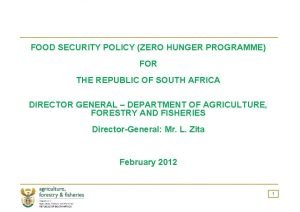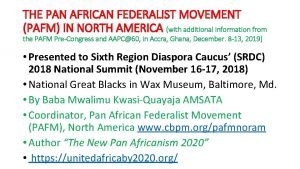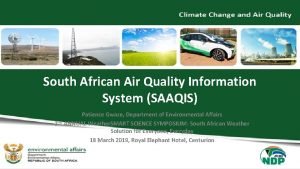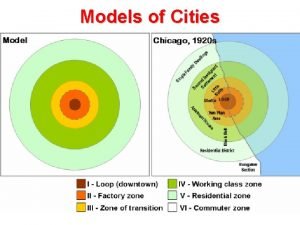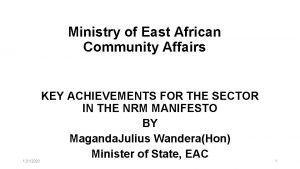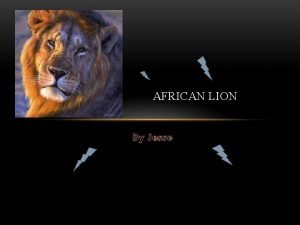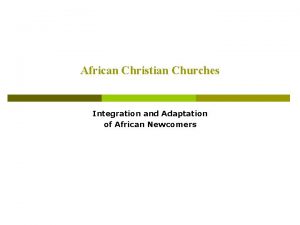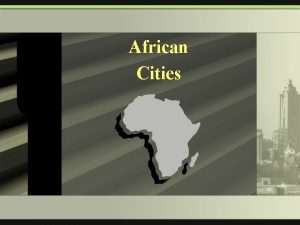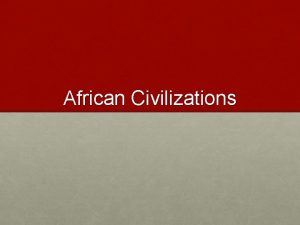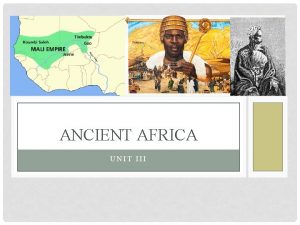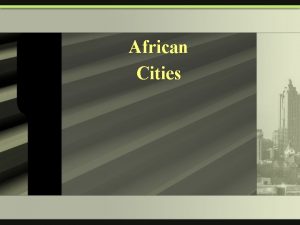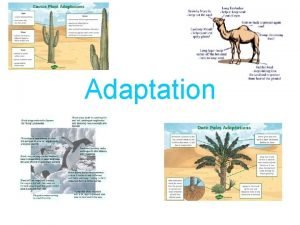African Adaptation Programme Africa Adaptation Programme Overview Presentation



















- Slides: 19

African Adaptation Programme Africa Adaptation Programme Overview Presentation By Ian Rector, Programme Manager Damascus, Syria September, 2010 Supporting Integrated and Comprehensive Approaches to Climate Change Adaptation in Africa

African Adaptation Programme • Funded by Government of Japan - $92 m • Duration 2009 – 2011 • 20 African Countries (includes Morocco and Tunisia in RBAS) • Not a traditional adaptation project – strategic focus establishing foundations for long term action • UN Partnerships UNICEF, UNIDO and WFP in 4 countries • Country driven and regionally supported –good balance

African Adaptation Programme Africa Adaptation Programme Overall Programme Objectives • Enhancing the adaptive capacity of vulnerable countries to climate change and disaster risks within the context of sustainable development • Promoting early adaptation through evidencebased solutions and initiatives for action • Laying the foundation for long-term investment to increase resilience to climate change and other threats across the African continent 2

African Adaptation Programme 20 Countries Burkina Faso Cameroon Congo Ethiopia Gabon Ghana Kenya Lesotho Malawi Mauritius Morocco Mozambique Namibia Nigeria Rwanda Sao Tome and Principe Senegal Tanzania Tunisia 3

African Adaptation Programme Outcomes In approaching this goal, Country Projects Have been designed to achieve a…. – Strengthening long term planning to enable countries to manage both existing and future risks associated with climate change and other causes – Building effective leadership and institutional frameworks for enhanced coordination and cohesion of programmes – Supporting the piloting of adaptation initiatives in the field – Identifying a range of financing options for sustained adaptation – Building knowledge management systems and promoting information sharing. Planned activities to ensure that interregional expertise and capacity development Is provided to 20 countries including. . . ü Advice and assistance relating to enhanced Government policy-making and planning in this field ü Support for leadership development and institutional reform as well as enabling individual development ü Encouraging exposure to world best practice and data ü Support in finding innovative funding options ü Creation of region-wide databases and learning opportunities 4

African Adaptation Programme RBAS COUNTRIES • Morocco and Tunisia • Strategic overview not technical presentation – follow up if more details required • National focus with specific pilot areas for piloting adaptation initiatives

– Morocco and Tunisia AAP projects African Adaptation Programme • Focus: climate proofing of territorial development and water management in Oases areas • Budget: 4 920 000 US$ (Japan : 2 975 000 US$ ; Government : 1 945 000 US$) – Tunisia: • Focus: climate-resilient coastal zone development • Budget: 2 975 000 US$ (Japan : 2 975 000 US$ ; Government : tbc) 6

Supporting Morocco African Adaptation Programme Some Examples • Establishing information database on CC impact scenarios • Creating tools for managing water resources • Establishing mechanisms for monitoring, tracking and reporting on observed climate changes • Mainstreaming CC into decentralized regional planning • Advocacy Plan for social mobilization • Capacity development and institutional strengthening – people and technology skills

African Adaptation Programme Project areas: Morocco • Western Oases region (Souss. Massa-Drâa, and Tata); • Oases of the Ziz valley (Errachidia, My Ali Cherif, Tinjdad, Goulmima) ; 8

African Adaptation Programme AAP – Morocco • Current status – Project officially launched in April 2010 – Several activities initiated: • Assessment of V&A and development of Territorial Adaptation Strategies for the Oases region using downscaling techniques and adaptation DSSs • Mainstreaming of CCA/DRR into local development plans programmes • Establishment of an EWS against flood and droughts risks • Implementation of two pilot adaptive water management systems • Support to CBA activities in water and agriculture • CB and awareness-raising activities aimed at key stakeholders of different levels – One complementary initiative being developed under the Adaptation Fund

Supporting Tunisia African Adaptation Programme Some examples • Strengthening forecasting and monitoring of CC impacts at national level • Developing adaptation decision making tools for coastal zone management • Strengthening institutional systems , capacity development and improving collaboration across agencies • Mainstreaming CCA into development land use planning • Exploring opportunities for innovative finance • Awareness raising

African Adaptation Programme Cap Bon Project areas: Tunisia 11

AAP – Tunisia African Adaptation Programme • Current status – Project officially launched in February 2010 – Several activities initiated: • Development of a National Adaptation Strategy for the Coastal Developement Sector • Formulation of a pilot climate-resilient ICZM and Shoreline Management Plans in the Cap Bon area • Development of a GIS-based SLR risk assessment and mapping tool • Implementation of ecosystem-based and soft coastal adaptation models in demonstration sites • Testing of technologies for the re-use of treated water for the artificial recharge of coastal groundwater • Communication activities (TV clips and knowledge products) – Two complementary initiatives being developed under the Adaptation Fund 12

African Adaptation Programme AAP – North Africa • Added-value • Offers a country-driven, meaningful and flexible response to un-addressed national CCA priorities • Provides a critical-mass of support and strong incentives to develop adaptive institutional frameworks and new collaboration modalities (‘’Enabling environment’’) • Promotes a strategic shift from ‘’stand-alone’’, opportunistic and scattered interventions to a more territorial, integrated and bottom-up approach to CCA • Acts as a ‘’catalyst’’ for leveraging additional funding and initiatives and provides a platform for building national /subnational adaptation coalitions (‘’multiplier effects’’) • Contributes to strengthen Regional and South-South Cooperation 13

African Adaptation Programme AAP – North Africa • Challenges – Mobilization of international expertise and transfer of best practices, including lessons from UNDP CCA/DRR global and regional portfolios – Linking climate change risks with development challenges requires specific analytical skills and demands rapid deployment of appropriate capacities and tools at all levels – Need for greater horizontal integration to reduce policy conflicts and more effectively address the adaptation deficit and maladaptive processes – DRR interventions in the short term require to be properly articulated with CCA to ensure adaptation effectiveness and avoid maladaptation in the longer term – Need to adopt an adaptive management style and to engage in “social learning” to deal with inherent uncertainty regarding long-term climate change – Going beyond a “technical quick fix” by catalysing a broad societal process and accelerating changes in policies and practices , particularly in water management 14

African Adaptation Programme AAP North Africa Opportunities for all: For Countries – strengthening sectoral capacities, improving leadership, coordination, information sharing and maximizing ownership For UN and other Regional Agencies: collaboration, leveraging and more focused support to address country needs For UNDP: Opportunity to refocus all practice teams toward one integrated programme of support

African Adaptation Programme AAP Conceptual Approach Slide 1: A national framework for mainstreaming CC/DRR and Gender within development strategies. It poses the question – When does climate change become a development issue? Most countries cannot afford to create dual systems and, the don’t have to. Slide 2: Adaptation or development strategies – what will work best? It depends on the coping and adaptive capacity gap.

African Adaptation Programme ? Climate Change Factors Temp Variation R/Fall Variation Sea Level rise Monitoring Loop Impact Analysis Development Social and Gender Inclusion Mainstreaming Framework Economic and Social Systems Eco Systems Critical infrastructure Natural Hazards Livelihoods other Sector wide planning and development Economic and Development Planning Disaster Management/DRR Risk Database PRSP NAPA Early warning systems Preparedness Planning Awareness Relief and Recovery Management Cross cutting Inputs (examples): Knowledge Management Information Management Capacity Development Advocacy and awarenessraising Policy and Planning Poverty Reduction and MDG Goals Lessons learned feedback loop 17

African Adaptation Programme Africa Adaptation Programme Adaptation or Development? ? • This slide demonstrates that in some cases the gap between existing coping capacity and existing/future risk may be so great that only long term development strategies may have an impact on reducing risk and vulnerability. Conversely, repeated disasters can erode coping capacity and extend the gap. CC Future Risk Predictions Predicted Adaptation Gap Existing Risk Levels Existing Adaptation Gap Existing adaptive/coping capacity Eroded Capacity
 Overview on the national tuberculosis elimination programme
Overview on the national tuberculosis elimination programme Zero hunger programme south africa
Zero hunger programme south africa Areanna ai
Areanna ai Diameters of fetal head
Diameters of fetal head Cephalic presentation
Cephalic presentation Powerful african kingdoms
Powerful african kingdoms African rainstick
African rainstick Hoyt sector model
Hoyt sector model Hoyt sector model
Hoyt sector model City model
City model African american fighter pilots
African american fighter pilots Animism traditions
Animism traditions Hamilton naki biografia
Hamilton naki biografia Pan african federalist movement
Pan african federalist movement South african air quality information system
South african air quality information system Northwest african countries
Northwest african countries Pan-african and independence comprehension check
Pan-african and independence comprehension check Chapter 8 lesson 5 african american culture and politics
Chapter 8 lesson 5 african american culture and politics Concentric models
Concentric models Ministry of east african community affairs uganda
Ministry of east african community affairs uganda

